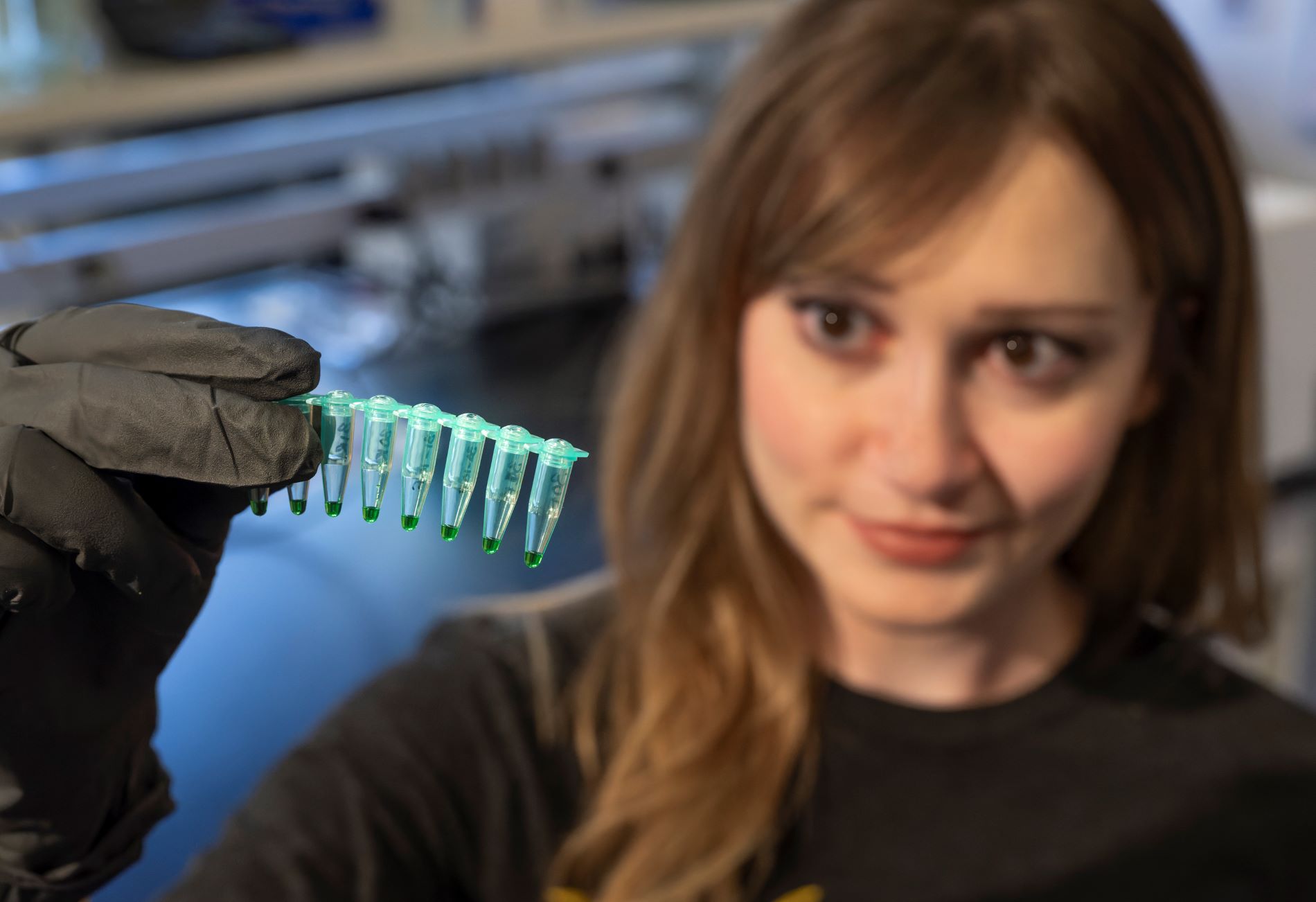CATALYST
DENVER MUSEUM OF NATURE & SCIENCE ONLINE MAGAZINE
What DNA Can Tell Us About Our World
A Behind the Science Conversation with the Scientists in our Genomics Lab

Tiffany Nuessle mentors Teen Science Scholar Program in the Genomics Lab. (Photo/ Rick Wicker)
In March 2024, the Museum welcomed Dr. Bridget Chalifour, a genomic scientist whose arrival doubled the size of the Health Sciences Department. She joined forces with Tiffany Nuessle, who manages the Genomics Lab. Together they’ve transformed the space from a traditional genetics lab into a dynamic hub for genomics research.
The Genomics Lab collaborates with other museum researchers to answer DNA-based questions across a wide range of organisms — including humans, birds and amphibians, among many others. It makes the lab a dynamic space with lots of collaborations going on and frequent visitors.
To introduce you to their work, we have sat down with Tiffany and Bridget to answer a few questions about their work:

Dr. Chalifour, in the Museum's Genomics Lab, holds product from a polymerase chain reaction, a process that essentially "photocopies" DNA. (Photo/ Rick Wicker)
Q: Why the shift from genetics to genomics?
While genetics is great for studying one or a few genes at a time, genomics allows scientists to study all of an organism’s DNA. Humans, for example, have around 20,000 genes which make up only around 2% of their DNA. The other 98% is known as “non-coding” DNA and scientists are just learning its importance. In addition, there are tiny organisms like bacteria, viruses and fungi that make a home on and in living things like people. These communities, called microbiomes, play a big role in how we stay healthy, and genomics helps us understand those relationships.
Q: Who uses the Genomics Lab?
Our lab supports scientists who study everything from birds and mammals to reptiles and spiders — and their microbiomes, too! Bridget works closely with colleagues to weave genomics into their research, while Tiffany performs the lab procedures with the help of a few highly trained volunteers. We love brainstorming and solving problems together and are as likely to generate laughter as new research studies on any given day. We thrive on cross-disciplinary partnerships and have plenty of exciting projects underway!
We also enjoy mentoring future scientists. Students and recent graduates join us in the lab to learn hands-on skills. This summer, Bridget and Genna Anderegg, our assistant invertebrate collections manager, are mentoring four high school students through the Teen Science Scholar Program, where their project will merge the fields of both genomics and entomology.
![Tiffany and [insert name] conduct investigative work in the Genomic Lab. (Photo/ Rick Wicker)](/media/rnqpk0gd/sss-tiffany-and-esmarie-nanospecing.jpg)
Tiffany and a Museum researcher conduct investigative work in the Genomic Lab. (Photo/ Rick Wicker)
Q: What challenges do you face in your work?
Museum collections are great for research, but older DNA is tricky. Over time, DNA breaks down — especially if the specimen wasn’t stored well. We use special methods to extract DNA from delicate, decades-old samples. That’s very different from getting fresh, high-quality DNA from living animals, like some of our colleagues can.
Q: What’s are a few surprising facts about DNA?
It’s hard to pick just a few! But here it goes:
-
Every living thing has DNA — from plants and snails to velociraptors, even the flesh-eating beetles we use in the museum to clean bones.
-
All humans have the same 20,000 genes, but tiny differences in them make us unique.
-
Some traits like dimples and certain diseases like sickle cell anemia are caused by a single change in one gene. But others, like eye color or colorblindness, come from several changes across multiple genes.

Dr. Bridget Chalifour carefully pipetting a sample in the lab. (Photo/ Rick Wicker)
Q: Is it true you’re doing human subject research again?
Yes! Our last human subject study was in 2018, part of the popular Genetics of Taste series. This time, we’re focusing on microbes — not the people themselves! We’re exploring how the bacteria found in a person’s nose — also known as their nasal microbiome — is connected to their time spent in nature and how they feel overall.
Q: Can Museum visitors get involved?
Absolutely! We’re teaming up with Adult Programs to offer this research at our Science Spotlight event on August 26. Visitors can learn about local microbiome research happening at the Museum and institutions nearby. There will be snacks, drinks, short talks — and a chance to join our study!
Summer 2025
In This Edition
-
Hunting for the Last Cretaceous Ecosystems of Peru
Museum Paleontologists Climb the Andes to Crack the Fossil Code
-
The Story Behind Nature Play’s Public Art Installations
Meet the Artists Helping to Shape a Unique Creative Play Experience in City Park
-
Museum Launches a New Way to Discover our Digital Collections
You Can Now Download Material Directly from Science Collections!
-
What DNA Can Tell Us About Our World
A Behind the Science Conversation with the Scientists in our Genomics Lab
-
Radiant Science! The Museum's Fluorescent Rocks
How the Museum is Assembling a Glow-in-the-Dark Mineral Display
-
Finding Direction in Our Current State of Affairs
The Institute of Science & Policy Provides Tools, Resources for Critical Thinking
-
The Museum Beadwork Collection Travels to Oklahoma
Building a New Model of Collaboration Between Tribal Governments and Cultural Institutions
Share this:
